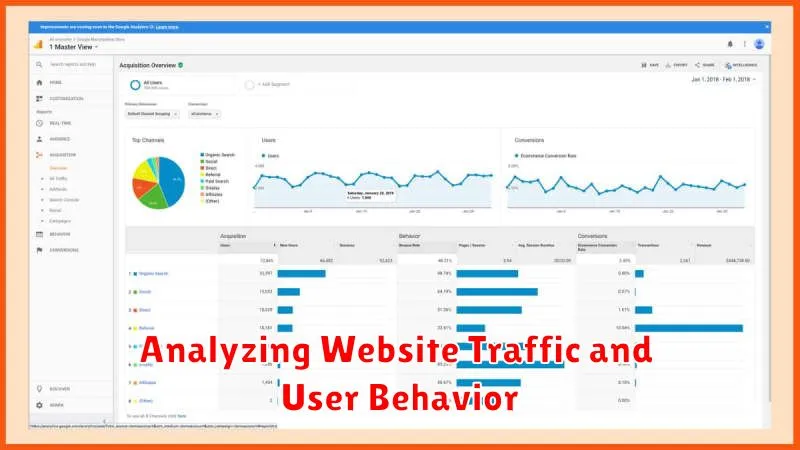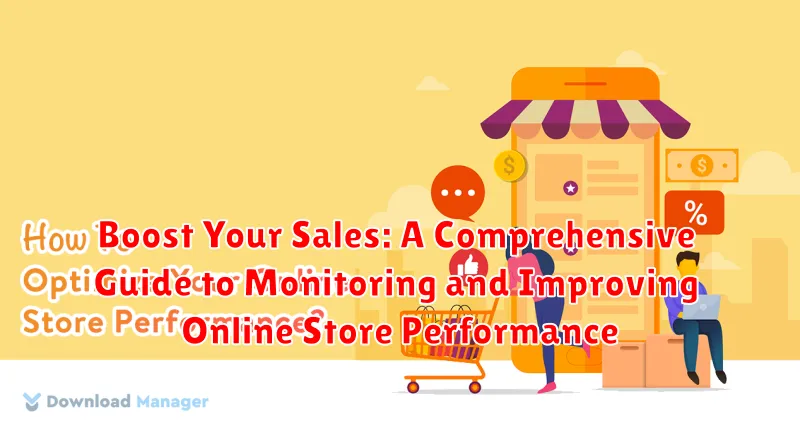In today’s competitive digital landscape, monitoring your online store’s performance is no longer a luxury, but a necessity. To boost your sales and achieve sustainable growth, a comprehensive understanding of key metrics, customer behavior, and market trends is crucial. This guide provides actionable strategies and practical advice for effectively monitoring and improving your online store performance, from optimizing product listings and enhancing user experience to leveraging data analytics and implementing targeted marketing campaigns. Whether you’re a seasoned e-commerce entrepreneur or just starting out, this guide offers valuable insights to help you thrive in the online marketplace and ultimately, boost your sales.
This comprehensive guide delves into the essential aspects of online store performance, offering a structured approach to monitoring and improvement. Learn how to identify key performance indicators (KPIs), track sales data, analyze customer behavior, and implement effective strategies to optimize your online store for maximum conversion. Discover the power of data-driven decision-making to boost your sales and stay ahead of the competition. From understanding website traffic and conversion rates to improving customer retention and driving repeat business, this guide equips you with the knowledge and tools to achieve significant improvements in your online store’s performance.
Key Metrics to Track for Online Store Success
Monitoring the right metrics is crucial for understanding your online store’s performance and identifying areas for improvement. Tracking these key metrics provides valuable insights into customer behavior and sales trends.
Conversion Rate: This measures the percentage of visitors who complete a desired action, such as making a purchase. A higher conversion rate indicates effective sales strategies and user experience.
Average Order Value (AOV): AOV represents the average amount spent per order. Increasing AOV can significantly boost revenue. Strategies include upselling, cross-selling, and offering bundled deals.
Customer Acquisition Cost (CAC): CAC is the cost of acquiring a new customer. Understanding CAC helps optimize marketing spend and ensure profitability. Lowering CAC is a key goal for sustainable growth.
Churn Rate: This metric tracks the percentage of customers who stop using your services or products. A high churn rate signifies potential issues with customer satisfaction or product quality.
Cart Abandonment Rate: This measures the percentage of customers who add items to their cart but don’t complete the purchase. A high abandonment rate can point to problems with the checkout process or shipping costs.
Utilizing Analytics Platforms for Actionable Insights
Leveraging analytics platforms is crucial for gaining actionable insights into your online store’s performance. These platforms provide valuable data that can inform strategic decisions and drive sales growth.
Google Analytics is a powerful and widely-used platform that offers comprehensive data tracking and reporting. It allows you to monitor website traffic, user behavior, conversion rates, and numerous other key metrics.
Other popular analytics platforms include Adobe Analytics, Mixpanel, and Heap. Each platform offers unique features and capabilities, so selecting the right one depends on your specific needs and budget.
Key features to look for in an analytics platform include customizable dashboards, real-time reporting, segmentation capabilities, and integration with other marketing tools.
By effectively utilizing these platforms, you can identify areas for improvement, optimize marketing campaigns, and ultimately boost your online store’s success.
Analyzing Website Traffic and User Behavior

Understanding website traffic and user behavior is crucial for optimizing your online store’s performance. By analyzing how users interact with your site, you can identify areas for improvement and enhance the customer journey.
Key areas to analyze include traffic sources, bounce rate, time spent on page, and pages per visit. Knowing where your traffic originates helps you determine which marketing channels are most effective. A high bounce rate may indicate issues with site design, navigation, or content relevance. Analyzing time spent on page and pages per visit can reveal which content resonates with your audience and how users navigate through your store.
User behavior analysis goes beyond these basic metrics. Examining click paths, heatmaps, and scroll depth provides a deeper understanding of how users interact with specific elements on your site. This information can guide you in optimizing product placement, call-to-action buttons, and overall website layout.
Strategies for Improving Website Conversion Rates
Improving website conversion rates is crucial for increasing sales and maximizing revenue. A strategic approach involves understanding user behavior and optimizing key elements of the online store experience.
Streamlining the checkout process is a primary tactic. Reducing the number of steps required to complete a purchase can significantly minimize cart abandonment. A clear and concise checkout page, coupled with multiple payment options, contributes to a seamless user experience.
Targeted promotions play a vital role in encouraging conversions. Offering limited-time discounts, free shipping, or bundled deals can create a sense of urgency and incentivize immediate purchases. Clearly displaying these promotions on product pages and throughout the website ensures maximum visibility.
Building trust and credibility is essential for converting hesitant shoppers. Displaying customer testimonials, security badges, and contact information prominently can reassure potential buyers about the legitimacy and reliability of the online store.
Optimizing Product Listings for Enhanced Visibility
Product listing optimization is crucial for attracting potential customers and driving sales. A well-optimized listing improves product visibility in search results, both internal and external.
Begin with compelling product titles. Incorporate relevant keywords that shoppers commonly use when searching for similar items. Maintain a balance between keyword richness and readability. Titles should be concise, accurate, and informative.
High-quality images are essential. Showcase the product from multiple angles, highlighting key features and benefits. Ensure images are clear, well-lit, and professionally presented.
Craft detailed and informative product descriptions. Clearly communicate the product’s features, specifications, and benefits. Address common customer questions and concerns. Use bullet points or lists for easy readability.
Finally, utilize relevant keywords and tags throughout the product listing. This improves search engine optimization (SEO) and helps customers find your products easily. Conduct thorough keyword research to identify the most effective terms.
Leveraging Customer Feedback to Drive Improvements
Customer feedback is a goldmine of information for improving your online store’s performance. Actively soliciting and analyzing feedback can reveal invaluable insights into customer preferences, pain points, and areas for improvement.
Implement a variety of feedback collection methods, such as post-purchase surveys, on-site feedback forms, and social media monitoring. Encourage customers to leave reviews and ratings on your products and services.
Analyze the collected feedback to identify recurring themes and trends. Pay close attention to both positive and negative feedback. Positive feedback highlights what you are doing well and should continue, while negative feedback pinpoints areas needing immediate attention.
Use the insights gained to make data-driven decisions. This might include improving product descriptions, streamlining the checkout process, or enhancing customer service interactions. By demonstrating that you value customer feedback and are actively working to address their concerns, you can build trust and loyalty, ultimately leading to increased sales and repeat business.
Boosting Sales with Effective Marketing Campaigns
Effective marketing campaigns are crucial for driving sales growth. A well-structured campaign can significantly increase brand visibility, attract new customers, and encourage repeat purchases. To achieve this, it’s essential to understand your target audience and tailor your messaging to resonate with their needs and interests.
Consider utilizing a variety of marketing channels to maximize reach. Social media marketing offers a powerful platform to engage with potential customers, build brand loyalty, and drive traffic to your online store. Email marketing allows for personalized communication and targeted promotions to nurture leads and boost conversions. Paid advertising, through platforms like search engines and social media, can quickly expand your reach and target specific demographics.
Tracking campaign performance is essential. Analyze key metrics such as click-through rates, conversion rates, and return on investment (ROI) to assess the effectiveness of your campaigns and make data-driven adjustments. Regularly review and optimize your campaigns based on these insights to ensure you are maximizing your marketing spend and achieving your sales goals.
Enhancing Customer Service for Increased Retention
Exceptional customer service is paramount to fostering loyalty and driving repeat business. A positive customer experience encourages retention and positive word-of-mouth referrals, ultimately boosting sales.
Implement strategies that prioritize personalized interactions. Addressing customers by name and referencing past purchases demonstrates individual attention and builds rapport.
Proactive communication is essential. Order updates and shipping notifications keep customers informed and reduce anxiety about their purchases. Follow-up emails after delivery soliciting feedback demonstrate a commitment to customer satisfaction.
Offering multiple communication channels, such as email, live chat, and phone support, caters to diverse customer preferences and ensures accessibility. Prompt and efficient responses to inquiries, regardless of the channel, are crucial for building trust and demonstrating professionalism. Empower customer service representatives to resolve issues quickly and effectively.
Monitoring and Adapting to Market Trends

Staying competitive in the dynamic online marketplace requires constant monitoring of market trends. Understanding shifts in consumer behavior, emerging product categories, and evolving technologies is crucial for sustained growth.
Effective trend monitoring involves utilizing various tools and resources. Market research reports, industry publications, and social media analytics provide valuable insights into current and future market directions. Analyzing competitor strategies and identifying emerging niches can also inform your business decisions.
Adapting to market trends requires agility and a willingness to experiment. This might involve adjusting product offerings, refining marketing messages, or implementing new technologies to meet evolving customer demands. Being proactive and responsive to changes ensures your online store remains relevant and competitive.

